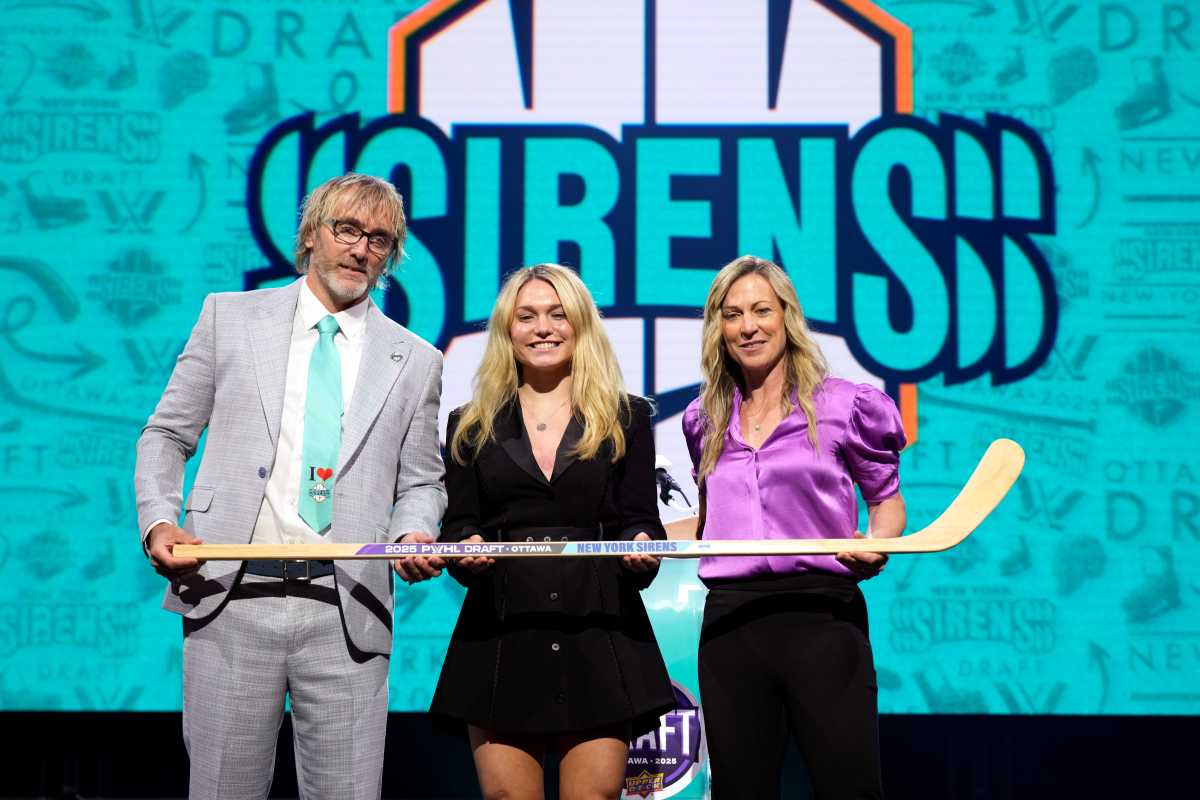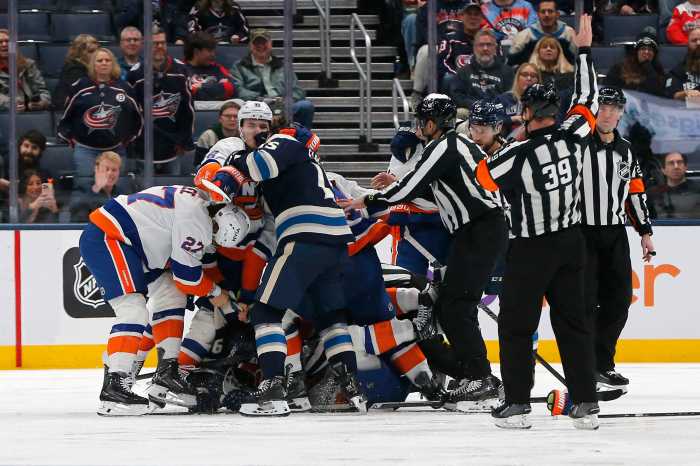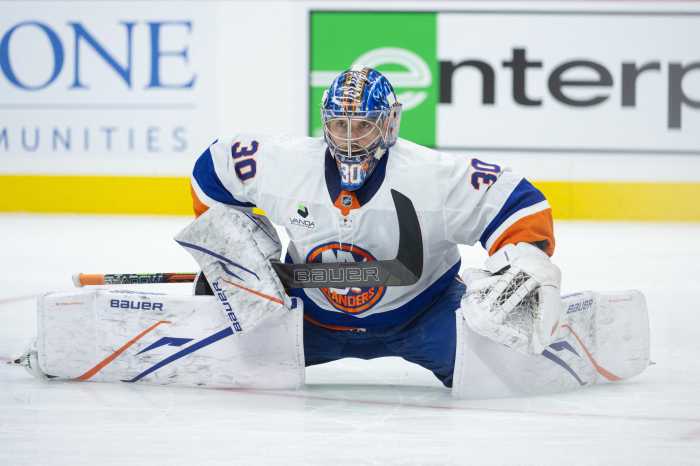When Casey O’Brien, the New York Sirens’ third overall pick in this year’s PWHL draft, gets the puck, her first thought is always the same: “How can I put my teammates in a position to succeed?”
No matter the situation — offensive zone, breakout, two-on-one — O’Brien operates with a “pass first” mindset. Watch any of her highlights from the Wisconsin Badgers women’s ice hockey team, where she just wrapped up a five-year collegiate career, and you’ll see this play out, over and over again. Her vision for the game, she said, is her biggest asset.
It’s why O’Brien leaves Wisconsin as the Badgers’ all-time leader in points (274) and assists (177).
“I love passing,” O’Brien told amNewYork. “I think setting someone up is more fun for me than scoring a goal.”
O’Brien is part of the Sirens’ offseason roster retool, following consecutive last-place finishes in each of the PWHL’s first two seasons.
New York drafted her with the number three pick in the 2025 PWHL Draft, which the club acquired from the Toronto Sceptres in exchange for defender Ella Shelton. The Sirens walked out of the draft with the two best forwards coming out of the NCAA — O’Brien and the first overall pick, Kristýna Kaltounková.
Adding O’Brien and Kaltounková as the headliners of a nine-player draft haul, Sirens general manager Pascal Daoust flipped defense for offense — the club’s biggest area of need after scoring the fewest goals in the PWHL last season.
O’Brien’s elite playmaking figures to help them. And, she’s coming home to New York.
‘It’s a little rough out there for a girl’
O’Brien was born in New York. She grew up in SoHo. She played hockey at Chelsea Piers. The O’Brien family moved to Boston when she was around the age of 10.
When O’Brien was younger, she dreamed of playing in the NHL. She knew it was unlikely. As a young girl, she was already thinking about what she was going to do other than playing hockey. Being an Olympian sounded cool. There was no PWHL.
If she could offer some advice to her younger self, she’d tell her: “Keep dreaming.”
“The fact that a six-, seven-year-old was already thinking about an alternative plan from what I actually wanted to do is kind of sad,” O’Brien said.
In Boston, O’Brien had tried out for a boys’ team. She didn’t make it.
“It’s a little rough out there for a girl,” she remembered the coach telling her and her family.
She credited Mark Jones, one of her first boys’ team coaches in the Boston area, for supercharging her development. He showed her that anybody could play hockey, no matter how aggressive the nature of the game. Soon, O’Brien was playing against some of the best boys in New England. Without Jones, she said, she wouldn’t have been able to play at such a high level.
O’Brien attended Noble and Greenough School in Dedham, MA. She led them to gold at the New England Championships in her freshman year, putting up 42 points. For her sophomore year, she joined Shattuck-St. Mary’s in Faribault, MN, is known for its elite hockey development program. She led her team with 80 points that year — 37 goals, 43 assists. In her junior year, she totaled 52 goals and 42 assists. She was named USA Today’s Girls Hockey Player of the Year.
O’Brien represented the United States twice at the IIHF U18 Women’s World Championship, winning gold in 2018.
But in O’Brien’s senior year, she was limited to just 23 games. She still put up 48 points, but missed extensive time with double hip surgery. She had bilateral FAI. The labrum in each of her hips was torn.
According to the Milwaukee Journal Sentinel, both of her older brothers, Max and Jack, have the same condition. And no one understands how to handle these situations better than Max, who played hockey at Colby College and had the surgery.
Asked who her hero was, O’Brien didn’t hesitate to offer Max’s name. He was the reason she started playing hockey. He showed her how to overcome situations athletes often face: getting injured and being cut from teams. When she’s struggling, she calls him. When things are going well, Max is her first call.
“Watching him do what he did and make it to where he did, all the stuff that he went through showed me,” O’Brien said. “He led the way, showed me what to do, how to handle situations.”
An undersized role model
Before each game, O’Brien picks three things to focus on. It may be something she didn’t execute well in the previous game. Maybe she saw something in a film session. Or a play she wants to make. Sometimes, it’s something as simple as playing aggressively.
After warm-up, she takes three to five minutes and puts her head in her hands to visualize herself having success, like winning the opening draw. Then, she feels ready to go.
O’Brien is 5-foot-4. She was usually the smallest player on her teams growing up. She idolized Kendall Coyne Schofield, the five-foot-two captain of the Minnesota Frost, and Martin St. Louis. She modeled her game after Coyne. Her similar stature, often seen as a disadvantage, has become a threat. Her skating and speed are her best assets, next to her vision on the ice.
“With her success at such a high level,” O’Brien said about watching Coyne, “And how she used her speed, how she managed to get through the physicality being so small, those are the biggest aspects that I took away from her game.”
Making the extra play
O’Brien was always taught that the best players are the ones who make those around them better. This mindset has carried her through her career. At higher levels, the goalies are better. Shots from the outside are less likely to go in than, for example, chances that force the goalies to move in tight.
Even when she gets a prime scoring opportunity, O’Brien looks to give someone else an easier chance, like a backdoor tap-in. That’s Wisconsin hockey, she said.
“A lot of the players at Wisconsin,” she said, “and a lot of the younger generation coming up, has that vision. They’re looking to make the extra play.”
It’s almost Sedin-esque.
The Badgers practiced two-on-ones every day. They worked down low. They simulated zone entries. They made their goalie, Ava McNaughton, who plays on the U.S. women’s national team, move from side to side. They found they had the most success with cross-ice and cross-seam passes.
Wisconsin was the highest-scoring team in the NCAA last season, scoring 221 goals over 41 games. The second-highest-scoring team, Ohio State, scored 155.
Many of the Badgers’ goals came on plays where a coach might have criticized the players for not shooting before a pass — as hockey fans will often groan during their team’s power play — but the “extra pass” strategy worked.
The Badgers beat Minnesota to win the WCHA championship. They beat Ohio State for the NCAA championship.
O’Brien ranked first in the nation in assists (62) and points (88). She was named the WCHA’s forward of the year and player of the year. She took home the 2025 Patty Kazmaier Memorial Award as the top player in NCAA Division I women’s ice hockey.
In NCAA women’s ice hockey last season, the top three players in assists per game were all Badgers. Five of the top 10 players in this metric were all from the team. O’Brien (1.51 assists per game) was first. She was followed by Kirsten Simms (1.15) and Caroline Harvey (1.10).
“We made it so easy,” O’Brien said.
She sees this part of her game transitioning seamlessly from the collegiate level to the PWHL.
“With the PWHL, obviously there’s a wide array of ages, but I think the younger generation coming in, like my class, especially the class coming to the Sirens,” O’Brien said, “We all think the game the same way. And so, when we’re going up against players who are more used to a straightforward game, we’re going to have a lot of success, and we’re going to be able to make a lot of offensive plays.”
Turning the Sirens around
O’Brien will inject elite playmaking, speed, and vision for the game into the Sirens’ remodeled lineup for 2025–26. She and Kaltounková, the first overall pick, form a lethal one-two punch at the center position.
If O’Brien earns the number one center responsibilities, she’ll get to play alongside Sarah Fillier, who was tied for the league lead with 29 points last season as a rookie. Fillier was also fourth in the league with 15 goals — an excellent complement to O’Brien’s pass-first style.
Long-term, O’Brien’s ambitions include a Walter Cup Championship — ideally, multiple — representing the U.S. at the Olympics and becoming the best player in the world. She sees a long playing career ahead of her. Afterward, she wants to stay in hockey as either a coach or general manager.
“I want to keep playing until the wheels fall off,” she said.
That’d be an ideal scenario for both O’Brien and the Sirens, who enter their third season with the foundation for sustained success in the years to come.
For more like this Casey O’Brien feature, visit AMNY.com
Also Read : https://www.amny.com/sports/sean-manaea-return-mets-7-14-25/






































